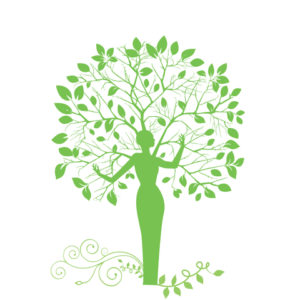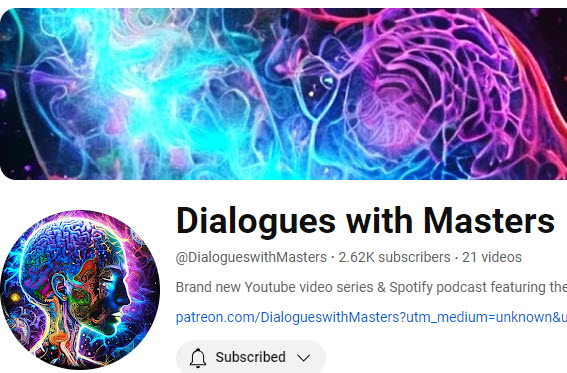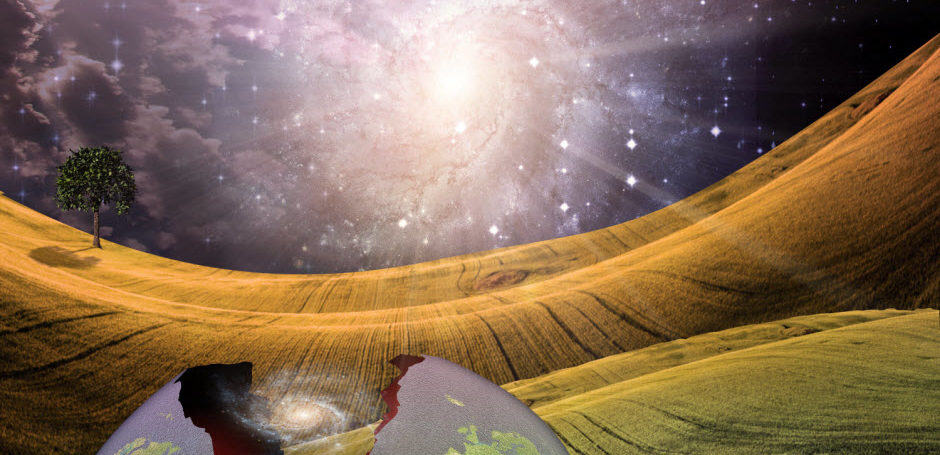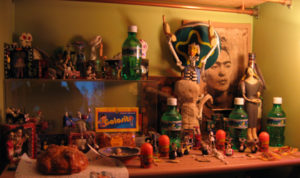 Lisa M. Christie, Ph.D. considers how psychic experiences of trees, normal among some peoples, may reveal dimensions hidden to ordinary sensory experiences.
Lisa M. Christie, Ph.D. considers how psychic experiences of trees, normal among some peoples, may reveal dimensions hidden to ordinary sensory experiences.
As part of his initiation into adulthood in the Dagara Tribe in Burkina Faso, Africa, the medicine man Malidoma Patrice Somé, who had been educated in Western schools, was told by his elders to “sit down and look at a tree until its true nature was revealed.” (1) Many of us raised in the West might find the elders’ instruction baffling or nonsensical: what could be the true nature of a tree (or anything) apart from what we see, hear, feel, smell, and taste, or know about it?
What Does It Mean to See the True Nature of Anything or Anyone?
If we were asked to describe the true nature of another human being, we might get a bit further. For example, imagine you meet a woman in her eighties who shows us photographs of herself at different stages of her life—as an infant, as a girl, as a young adult, and now as an older woman. What is her true nature? Considering this question, you would likely seek to go beyond her ordinary physical appearance and beyond your ideas of who she is based on what you have been taught about her gender, race, age, socioeconomic class or any other external factors; and to seek to get a sense of her “hidden,” “inner,” psychological and/or spiritual dimensions of being. You might talk with her, work alongside of her, or sit in her presence and simply intuitively feel her as a person. If you made a careful effort, you would undoubtedly come away knowing much more about who she is than your initial superficial impressions or preconceived ideas might have suggested. You might even find that some of your initial perceptions were incorrect.
Does Nature Have Awareness?
Fine, you might say, but still there is a world of difference between a woman and a tree: A woman has a mind, consciousness, whereas a tree is a plant, which almost all of us in the West are taught has no experience. Rather, we are told, it is a living thing, that has no subjective or “inner” life. But do we know that, really? How would we know?
The German Jewish theologian Martin Buber, who wrote of having an “I-Thou” relationship with nature, writes, “The tree will have a consciousness, then, similar to our own? Of that I have no experience.” (2). The prevailing belief in the West is that a tree does not have experience is purely speculative, based on a series of assumptions, beginning with the idea that “matter” has no experience and that awareness and “thinking” requires a brain and a nervous system. However, as I will discuss in upcoming blog posts, many discoveries in the new studies of science suggest otherwise.
Until relatively recently, most peoples have believed that other entities in nature have awareness and their own purposes, that they too have their “inner” dimension. Many Indigenous people, most Pagans, and a more limited number of people of the Christian and Jewish faiths, still do believe that nature is filled with awareness and intelligence. These beliefs are often grounded in human experiences that are considered natural and normal within those cultures.
Seeing vs. Looking
The anthropologist and author Carlos Castaneda said that he received from his Yaqui Indian teacher Don Juan Matus the instruction to see certain events rather than merely look. Seeing involves going beyond what is present to our ordinary sensory experiences (sensory experiences as they are commonly conceived and attended to in the West) to see what goes beyond the limitations of that experience. Casteneda explains that seeing involves “stopping the world,” meaning stopping our continual flow of ideas about the world, which shapes the world as we ordinarily experience it. (3) Psychologists who study perception have shown that our concepts of the world, as well as our physiology, have a material influence on what we perceive. Although it is difficult–some say impossible–to let go of all of our preconceptions and experience reality just as it is, we can learn to see beyond our usual ways of perceiving the world by learning to let go for the moment of our concepts and expectations of ourselves and the world, even our ideas of how and what we can know. It means opening more fully to what is present beyond concepts and ordinary sensory experiences, a goal of many forms of meditation.
What Might It Be Like to Really See a Tree?
So, what might it be like to really see a tree? To answer that question, we might consider the experiences of others and explore what might be true for us. Somé, the a medicine man who had been educated in Western schools, recalls finding the idea of looking at a tree until its true nature was revealed “completely absurd.” He explains, “My rather Westernized mind . . . was totally unable to grasp what it meant just to sit down and look at a tree.”
Somé struggled for about thirty hours, experimenting with various answers that might satisfy the elders; however, each time they sent him back to try once again. Feeling shame and despair at his apparent inability to complete this apparently simple task, he began to talk to the tree as if to another human being. He recounts: “As I looked at it, I suddenly began speaking to it, as if I had finally discovered that it had a life of its own. I told it all about my discontent and my sadness and how I felt that it had abandoned me to the shame of lying and being laughed at.” (5) He acknowledged that he simply lacked the ability to see what was before him. As so often happens when our rational mind acknowledges its limitations, his experience of reality shifted. Somé recalls:
“What happened next is the kind of experience that . . . molded my perception forever. The tree that I had been watching for so long was no longer there, and in its place was a beautiful green lady. I do not know if the tree became her, or if she stepped out of the tree, but this doesn’t really matter. Where the tree had been there was now a figure that looked like a human being, in the shape of a woman, very tall, probably seven and a half feet tall. Her tunic was silky and black, and she wore a veil over her face, and when I looked again, she had lifted the veil, revealing an unearthly face. I call her the green lady because she was green. But the greenness in her had nothing to do with the color of her skin. She was green from the inside out, as if her body were filled with green fluid. I do not know how I knew this, but this green was the expression of immeasurable love.
” . . . . As soon as she appeared I felt some sort of shock that enveloped my whole body. It produced in me a feeling of the type that I had never experienced before and that I’ve never experienced again. There was a magnetic pull towards her, and I don’t know how I got there, whether I crawled or ran, but I found myself in her arms. It was a homecoming of utmost healing. I was sobbing as I had never done before, for I felt that I was in the hands of the ultimate divine being, hands that provided the ultimate sense of acceptance and home that could never be denied.” (6)
This feeling of love and support was so compelling that Somé wished to remain in the arms of the green lady forever. But, the moment came when she told him that she needed to go and that he needed to continue with his life. Although Somé tried to hold on to her, he gradually began to feel the hard bark of the tree against his body as he embraced it and saw the tree as it had originally appeared to him. He recounts one of the elders saying, “They are always like this. First they resist and play dumb . . . and then when it happens, they won’t let go either.” (7)
Seeing Trees
There are many other accounts of women’s and men’s psychic experiences of trees, each perhaps shedding more insights regarding their nature. Many Indigenous people talk to the land, to the entities of the natural world, and feel they respond. Many say that the learned about the healing powers of certain plants from the plants themselves. As one of many examples, the anthropologist of American Indian descent, Barbara Tedlock was taught by her mother, a shaman, to use certain plants for healing and to make offerings to them and gain their permission before taking them. She explains, “Through these lessons I gradually became aware that each species, and indeed each plant, possessed an energy or life essence of its own. Not only were the plants living beings, but they could also communicate with me. Many had special songs.” (8)
Tedlock recalls one instance in which she was alone in the woods and heard a sweet voice singing, “As I looked around I saw several purple coneflowers swaying gracefully in the breeze. The song was clearly coming from one of them.” (9) She dug up one of the flowers and learned that its root was useful medicine for recovering from colds and flu.
In some spiritual practices or exercises exploring the possibilities of consciousness, some people have described exceptional experiences in which they felt themselves to be a tree and saw the world around them in a new way. The psychiatrist and researcher Stanislav Grof shares the following account of one of his informants who, using a technique for shifting consciousness pioneered by S. Grof and the psychotherapist Christina Grof, experienced complete identification with a Sequoia redwood tree:
“The most superficial level of my experience seemed to be very physical and involved things that Western scientists have described, only seen from an entirely new angle—as conscious processes guided by cosmic intelligence, rather than mechanical happenings in organic or unconscious matter:
“My body actually had the shape of a Sequoia tree, it was the Sequoia. I could feel the circulation of sap through an intricate system of capillaries under my bark. My consciousness followed the flow to the finest branches and needles and witnessed the mystery of communion of life with the sun—the photosynthesis. My awareness reached all the way into the root system. Even the exchange of water and nourishment from the earth was not a mechanical but a conscious, intelligent process.
However, the experience had deeper levels that were mythical and mystical, and these dimensions were intertwined with the physical aspects of Nature. . . . The natural processes such as rain, wind, and fire had mythical dimensions and I could easily perceive these as deities, the way they were perceived by most aboriginal cultures.”
These and many other experiences suggest that there may be many ways to perceive trees, each providing new insights into “tree-ness” and particular trees. Some of these experiences were spontaneous; others, such as those of Somé and Tedlock, arose from the use of active imagination, which we might see as replacing one set of concepts with another. This practice of experimental imagination appears to open the door to aspects of experience that are hidden from our ordinary ways of thinking about the world—which can also stem from a kind of imagination, one which imagines reality to be “just so.”
In the same way that we might know a person in many more ways than simply by looking at them and seeing primarily our assumptions and expectations of him or her, we might gain more insights about other entities in nature and the world in which we live by employing other ways of knowing, including psychic ways of knowing. These expanded ways of knowing might have profound consequences for the way we live. Perhaps if we learn to see ourselves and the world in more depth, we might find ourselves feeling ourselves to be part of the community of nature. Perhaps we might increasingly value harmony with all of the other entities of nature, including other people. And perhaps that might lead us to become better citizens of the cosmos.
I would love to hear your thoughts. What psychic or spiritual experiences have you had of other entities in nature? What do you make of them?
Lisa Christie, Ph.D.
Originally published August 15, 2014
Lisa Christie, Ph.D., ACC is a writer, adjunct lecturer at the California Institute of Integral Studies, speaker, and spiritual coach. You can learn more about her at About Lisa Christie.
Like this blog?
Then please subscribe using the form at the upper right side of this page, so you can receive our articles to your inbox.
Are you on Social Media?
Follow me on Facebook, Twitter, or Instagram:
Facebook: https://www.facebook.com/LisaMChristiePhD
Twitter at http://www.Twitter.com/LisaChristiePhD
Instagram at https://www.instagram.com/lisamchristiephd/
Notes
1. Malidoma Somé, The Healing Wisdom of Africa: Finding Life Purpose through Nature, Ritual, and Community. (New York: Jeremy P. Tarcher/Putnam, 1999), 44.
2. Martin Buber, I and Thou. Translated by Walter Arnold Kaufmann. 2nd ed. (London: Continuum, [1937] 2004), 15.
3. Carlos Castaneda, Teachings of Don Juan: A Yaqui Way of Knowledge. (New York: Washington Square Press, 1985).
4. Somé, Healing Wisdom of Africa, 44.
5. Ibid., 44-45
6. Ibid.
7. Ibid.
8. Barbara Tedlock, The Woman in the Shaman’s Body: Reclaiming the Feminine in Religion and Medicine. (New York: Bantam Books, 2005), 133.
9. Ibid.
10. Stanislav Grof, The Holotropic Mind: The Three Levels of Human Consciousness and How They Shape Our Lives. (San Francisco: HarperSanFrancisco, 1993), 111.




